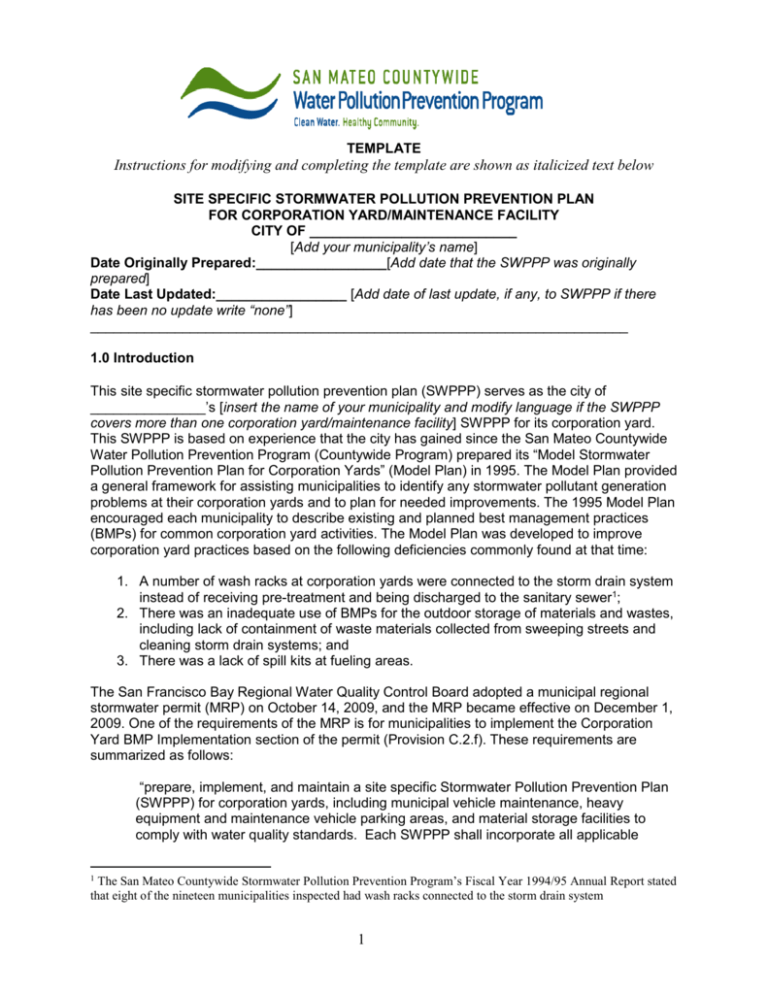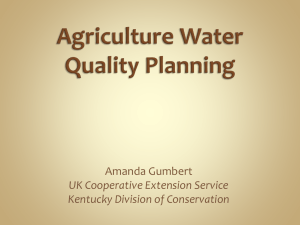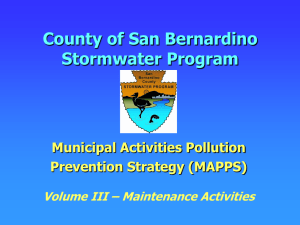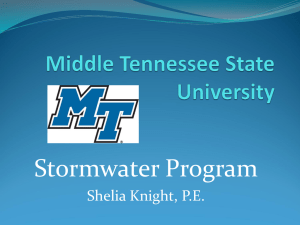1.0 Introduction - San Mateo Countywide Stormwater Pollution
advertisement

TEMPLATE Instructions for modifying and completing the template are shown as italicized text below SITE SPECIFIC STORMWATER POLLUTION PREVENTION PLAN FOR CORPORATION YARD/MAINTENANCE FACILITY CITY OF ___________________________ [Add your municipality’s name] Date Originally Prepared:_________________[Add date that the SWPPP was originally prepared] Date Last Updated:_________________ [Add date of last update, if any, to SWPPP if there has been no update write “none”] ______________________________________________________________________ 1.0 Introduction This site specific stormwater pollution prevention plan (SWPPP) serves as the city of _______________’s [insert the name of your municipality and modify language if the SWPPP covers more than one corporation yard/maintenance facility] SWPPP for its corporation yard. This SWPPP is based on experience that the city has gained since the San Mateo Countywide Water Pollution Prevention Program (Countywide Program) prepared its “Model Stormwater Pollution Prevention Plan for Corporation Yards” (Model Plan) in 1995. The Model Plan provided a general framework for assisting municipalities to identify any stormwater pollutant generation problems at their corporation yards and to plan for needed improvements. The 1995 Model Plan encouraged each municipality to describe existing and planned best management practices (BMPs) for common corporation yard activities. The Model Plan was developed to improve corporation yard practices based on the following deficiencies commonly found at that time: 1. A number of wash racks at corporation yards were connected to the storm drain system instead of receiving pre-treatment and being discharged to the sanitary sewer1; 2. There was an inadequate use of BMPs for the outdoor storage of materials and wastes, including lack of containment of waste materials collected from sweeping streets and cleaning storm drain systems; and 3. There was a lack of spill kits at fueling areas. The San Francisco Bay Regional Water Quality Control Board adopted a municipal regional stormwater permit (MRP) on October 14, 2009, and the MRP became effective on December 1, 2009. One of the requirements of the MRP is for municipalities to implement the Corporation Yard BMP Implementation section of the permit (Provision C.2.f). These requirements are summarized as follows: “prepare, implement, and maintain a site specific Stormwater Pollution Prevention Plan (SWPPP) for corporation yards, including municipal vehicle maintenance, heavy equipment and maintenance vehicle parking areas, and material storage facilities to comply with water quality standards. Each SWPPP shall incorporate all applicable The San Mateo Countywide Stormwater Pollution Prevention Program’s Fiscal Year 1994/95 Annual Report stated that eight of the nineteen municipalities inspected had wash racks connected to the storm drain system 1 1 BMPs that are described in the California Stormwater Quality Association’s Handbook for Municipal Operations and the Caltrans Storm Water Quality Handbook Maintenance Staff Guide, May 2003, and its addenda, as appropriate.” The site specific SWPPP is required to be completed by July 1, 2010. In addition, municipalities are required to: “(1) Implement BMPs to minimize pollutant discharges in stormwater and prohibit nonstormwater discharges, such as wash waters and street sweeper, vactor, and other related equipment cleaning wash water. Pollution control actions shall include, but not be limited to, good housekeeping practices, material and waste storage control, and vehicle leak and spill control. (2) Routinely inspect corporation yards to ensure that no non-stormwater discharges are entering the storm drain system and, during storms, pollutant discharges are prevented to the maximum extent practicable. At a minimum, an inspection shall occur before the start of the rainy season.” 2.0 Related Pollution Prevention Plans In addition to this SWPPP, there are two [modify number as appropriate for your municipality] other existing plans that describe pollution prevention activities at the corporation yard facility. A Spill Prevention Control and Countermeasure (SPCC) Plan was prepared in accordance with requirements set forth in Title 40 of the Federal Code of Regulations. The SPCC Plan contains operating guidelines for spill prevention and control of petroleum hydrocarbons stored at the facility. In addition, spill response procedures and an inventory of the hazardous materials stored at this facility are described in the facility’s Hazardous Materials Business Plan (AB 2185 Business Plan). This site specific SWPPP was developed by considering the SPCC plan; the facility’s Hazardous Materials Business Plan; the Countywide Program’s Template Site Specific SWPPP Plan; specific activities conducted at the corporation yard; the Countywide Program’s existing BMPs2; and the new MRP’s requirements including all applicable and appropriate BMPs described in the California Stormwater Quality Association’s Handbook for Municipal Operations (2003) and Caltrans’ Storm Water Quality Handbook Maintenance Staff Guide (2003). 3.0 Facility Description The corporation yard is located at _____________ [insert the address of the corporation yard covered by this SWPPP ] and comprises approximately _________acres [add information]. The following activities are conducted at the corporation yard: 1. Vehicle and equipment washing; 2. Vehicle and equipment maintenance and repair; 3. Fuel dispensing; 4. Municipal vehicle, heavy equipment, and employee parking; 5. Waste and recycling storage; and 6. Outdoors materials storage. The Countywide Program’s “Tips for a Cleaner Bay How Your Business Can Prevent Stormwater Pollution” and the “Vehicle Service Facility BMPs” are particularly relevant. 2 2 [Modify the above list based on the specific types of activities that occur at your corporation yard.] The city [or change to county, if appropriate] uses appropriate BMPs to minimize the potential contribution of pollutants to stormwater and to prevent the possibility of creating a nonstormwater discharge disallowed by the MRP. The facility site map (Figure 1) depicts the corporation yard and provides the following information: Boundaries of the corporation yard; Footprint of all buildings, structures, and paved areas including parking lots. Location of activities that could potentially contribute pollutants to stormwater or cause a nonstormwater discharge; Stormwater collection and conveyance system including the direction of stormwater drainage to storm drain inlets at the facility; On-site surface water bodies, if any; Portions, if any, of the corporation yard impacted by run-on from surrounding areas; Locations of any BMPs that prevent stormwater pollution, treat stormwater runoff, or recycle washwaters for discharge to the sanitary sewer. [Insert a figure showing the corporation yard with the appropriate information or modify the list of items included on the figure to cover what is reasonably available or delete above text that refers to having a facility site map] 4.0 Corporation Yard Pollution Prevention Team The stormwater pollution prevention team responsible for assisting the corporation yard’s management to implement, maintain, provide training, and update this site-specific SWPPP and conduct corporation yard inspections consists of the following individual(s): ___________________________________________ Corporation Yard Manager ___________________________________________ Vehicle Maintenance Facility Manager ___________________________________________ Corporation Yard SWPPP Lead ___________________________________________ Corporation Yard BMP Inspector ___________________________________________ Corporation Yard BMP Trainer [list name, job title, and role for each person who has an essential role in assuring the implementation of the SWPPP. Roles other than those listed may be used, so modify list of roles as appropriate] 3 5.0 Corporation Yard BMPs The following sections describe general BMPs and activity specific BMPs that are used at the corporation yard to minimize the discharge of pollutants in stormwater to the maximum extent practicable and to effectively prohibit non-stormwater discharges that are disallowed by the MRP. 5.1 General Good Housekeeping BMPs Good housekeeping, such as maintaining a clean and orderly facility, is practiced at the corporation yard in order to minimize the risk of contributing litter and other pollutants to stormwater. In addition, pollution prevention practices are used at the corporation yard to prevent pollutants from coming in contact with stormwater runoff. Examples of good housekeeping and pollution prevention practices employed include the following BMPs: A clean and orderly corporation yard is maintained. Materials that have the potential to discharge pollutants to stormwater are covered prior to predicted rains and during rainfall events if these materials cannot be stored permanently under a roofed or covered area. Container lids are closed when not in use. Storm drain inlet labels are maintained. A sufficient number of covered litter receptacles are provided at the corporation yard and they are cleaned out frequently enough to prevent overflow and spillage. Materials and wastes that may be spilled or mobilized by stormwater are stored as far away from storm drain inlets as practical. Vehicles and equipment are maintained to minimize drips and leakage. Drip pans or absorbent pads are used under leaking vehicles and equipment to capture fluids. Spill clean up occurs promptly. Spill containment kits are stored in locations that have the potential for spills. Washwaters and other non-stormwater discharges disallowed by the MRP are prevented from being discharged to the storm drain system. Maintenance staff who work at the corporation yard have been trained on the use of these general good housekeeping BMPs. The corporation yard is inspected weekly to make sure BMPs are being appropriately used. [modify this list of BMPs as appropriate to your corporation yard.] 5.2 Activity Specific BMPs The following BMPs or their equivalent are implemented at the city’s corporation yard in order to comply with the MRP’s requirements. [Delete any of the following activities and associated lists of BMPs if they are not applicable to your corporation yard.] Vehicle and Equipment Washing The following vehicle and equipment washing BMPs are used at the corporation yard. 4 1. Vehicle and equipment washing activities are located under a roof or in a building equipped with a municipal sewer connection or closed loop system. 2. There is an outdoor equipment washing area that has the following characteristics: The area is paved and surrounded by berms or graded to prevent washwaters from flowing off and stormwater from adjoining areas from flowing onto the wash area. The wash area is sloped for washwater collection. Washwaters drain to a dead-end sump or to an oilwater separator and the sanitary sewer. 3. The wash area is adequately sized to minimize drag-out from washed vehicle so that there is no flow to storm drain inlets and to allow the washing of large vehicles entirely within the wash area containment system. 4. All vehicle washing systems are maintained and cleaned out on a regular schedule. 5. A trash container is provided in or nearby the wash area. 6. Staff responsible for washing vehicles and equipment have been trained on proper cleaning and wash water disposal procedures and refresher training occurs on a regular basis. [Modify as needed to tailor to your corporation yard. For example, describe how vehicles and/or equipment are cleaned in a way that prevents washwaters from draining to the storm drain system. One possible option is that vehicles and/or equipment are only washed or steam cleaned offsite at a location that flows to the sanitary sewer.] Vehicle and Equipment Maintenance and Repair The BMPs listed in this section are used to prevent or reduce the discharge of pollutants to stormwater from vehicle and equipment maintenance and repair activities. 1. Vehicle and equipment maintenance and repair activities are conducted indoors whenever feasible. 2. Maintenance activity areas are kept clean, well organized, and equipped with clean up supplies. 3. Vehicles and equipment are maintained to minimize drips and leakage. 4. Used fluids are promptly transferred to the proper waste or recycling drums/containers. Drain and drip pans or open containers are not left lying around. 5. Dry clean up methods, such as sweeping, vacuuming, and/or a damp mop, are used. Vehicle equipment and maintenance and repair areas are never hosed down unless all of the washwater is collected and disposed to the sanitary sewer. 6. The vehicle and equipment maintenance and repair area is swept at least weekly. 7. Drip pans are used under leaky vehicles and equipment, and absorbent pads and materials are used as appropriate. 8. Used absorbent material from cleaning small spills is promptly and properly removed. 9. All fluids from wrecked vehicles are drained immediately using a drain or drip pan that is adequately sized. 10. Outdoor vehicle and equipment maintenance are not performed during rain events unless required by emergency conditions. 11. If temporary work must be conducted outdoors, a tarp, ground cloth, or drip pan is placed under the vehicle or equipment to capture spills and drips. 12. Staff responsible for vehicle and equipment maintenance and repair has been trained on the use of these BMPs and refresher training occurs on a regular basis. [Modify as needed to tailor to your corporation yard.] 5 Fuel Dispensing Vehicle and equipment fueling procedures and BMPs are used to minimize or eliminate the discharge of spilled or leaked fuel to stormwater. 1. The fueling area is covered with a roof or canopy so that rainwater cannot come into contact with the fueling area. 2. The fueling area is paved with Portland cement concrete (or an equivalent smooth, impervious surface) with a 2 to 4% slope to prevent ponding, and it is separated from the rest of the site by a grade break that prevents run-on of stormwater to the extent practicable. 3. Signs are posted to remind employees not to top of the fuel tank. 4. The fuel dispensing area is kept clean using dry cleanup methods, such as sweeping or vacuuming to remove litter and debris and rags or absorbents to spot clean leaks and drips. 5. Spill containment kits are kept readily accessible in the fueling area. 6. A current spill response plan is maintained for fueling operations. 7. The fueling area is inspected daily during use and any deficiencies found are corrected. 8. Staff responsible for fueling has been trained on the use of these BMPs and the SPCC Plan. Refresher training occurs on a regular basis. [Modify as needed to tailor for your corporation yard.] Municipal Vehicle, Heavy Equipment, and Employee Parking The following BMPs for municipal and employee parking areas are used to control potential stormwater pollutants, such as litter and oil from leaking vehicles. 1. 2. 3. 4. Parking lots are kept clean and orderly. Litter and debris are removed in a timely fashion. Trash receptacles are provided in the parking lot to discourage littering. Parking lots are swept weekly to prevent the accumulation of litter and debris. When surface cleaning is needed, BASMAA’s3 “Pollution from Surface Cleaning” BMPs are used. 5. Paving and other equipment that have the potential to drip have drip pans or absorbent materials placed under the equipment to contain any leaks or spills. 6. Heavy equipment is inspected for leaks during each work day and repairs are made as soon as possible. 7. Drip pans or absorbent material are used under leaking vehicles and equipment to capture fluids until repairs can be made. 8. Parking lots are inspected at least weekly to assure compliance with these BMPs. 9. Staff who park municipal vehicles, heavy equipment, and private vehicles at the corporation yard have been trained on the use of these BMPs. [Modify as needed to tailor for your corporation yard.] Waste and Recycling Storage The following waste handling and storage BMPs are used to prevent wastes and recyclables from contributing pollutants to stormwater or causing a non-stormwater discharge disallowed by the MRP. 3 Bay Area Stormwater Management Agencies Association. http://www.basmaa.org/Portals/0/documents/pdf/Pollution%20from%20Surface%20Cleaning.pdf 6 1. Waste collection and recycling areas are kept clean. 2. Dumpster and waste recycling areas are inspected, swept, and picked up daily during work days. 3. Rubbish and recyclables that have been collected from streets and storm drains are stored under a roof or cover, if possible. Dumpsters and recycling containers are not overfilled, and lids are kept closed when not in use. 4. Street sweeping wastes and materials removed during storm drain cleaning are stored on a concrete or asphalt pad in a contained area as far away from storm drain inlets as practical. Water, including decanted water from vactor trucks, drains to the sanitary sewer or is allowed to evaporate so that it does not flow to storm drain inlets. 5. Hazardous wastes are stored in compliance with hazardous waste regulations including the use of appropriate containers constructed of compatible materials with the lids securely closed when not in use. 6. An ample supply of appropriate spill cleanup materials is located near waste storage areas. 7. In the event of a spill, dry clean up methods are used. 8. Staff responsible for waste storage has been trained on the use of these BMPs, and refresher training occurs on a regular basis. [Modify as needed to tailor for your corporation yard.] Outdoor Material Storage The BMPs listed below are used to control pollutants from the outdoor storage of raw material at the corporation yard: 1. To the extent feasible raw materials are stored inside. 2. To the extent feasible materials that must be stored outside are stored in a roofed area that is bermed to prevent contact with stormwater. 3. Stockpiles of raw materials that cannot be stored under a roof are kept covered when the material is not being used. Temporary waterproof covering may be made of polyethylene, poly propylene or hypalon. 4. If stockpiles are so large that they cannot feasibly be stored under a roof or covered, erosion control BMPs are used at the perimeter of the stockpile and at any storm drain inlet to prevent erosion of stockpiled material off site. 5. Fluids are stored within secondary containment to prevent accidental release. 6. Caution and control are used when transferring liquids to minimize potential spills. 7. Container lids, caps, and openings are kept closed when not in use. 8. Containers are kept out of pooled or standing water, and storage areas are kept clean. 9. Storage area pavements have sufficient slope to avoid pooling of water in areas where materials, such as compost and wood chips, may leach pollutants into stormwater. 10. Tanks are surrounded by berms that provide secondary containment. 11. Regular inspections of storage areas are conducted to detect leaks and spills. 12. Spill containment kits are kept in outdoor material storage areas. 13. Staff responsible for raw material storage and handling outdoors has been trained on the use of these BMPs including spill clean up procedures, and refresher training occurs on a regular basis. [Modify as needed to tailor for your corporation yard.] 7





